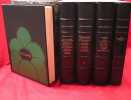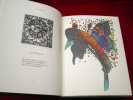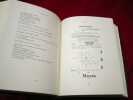13 books for « apollinaire guillaume... »Edit
"APOLLINAIRE, GUILLAUME - PICASSO (ILLUSTR.) - JEAN COCTEAU - LÉON BAKST - SERGE DIAGHILEV.
Reference : 60103
(1917)
BALLETS RUSSES. PROGRAMME. PARIS 1917. Les Ballets Russes a Paris. Représentations Exceptionelles avec le gracieux Concours des Artistes de M. Serge de Diaghilew. - Programme des Ballets Russes. Les Ballets Russes à Paris. Saison - Mai 1917. [Guillau... - [HAND-PAINTED BY PICASSO - COINING ""SURREALISM""]
Paris, Mai 1917. Folio. Original illustrated extra wrappers (with a picture by Picasso on the front and the décor for ""Baba Iaga"" on the back)"" original illustrated wrappers for ""Théatre du Chatelet"" (drawing by André Marty on front, and advertisements on back) in grey and red"" original illustrated coloured wrappers for ""Programme des Ballets Russes"" (front wrapper illustrated by Picasso with the Chinaman-costume from ""Parade""). A bit of soiling to the extra-wrappers and small professional restorations to upper front cover and top of spine (this barely noticeable) as well as to blank margin of back wrapper. Apart from that, an excellent and very well perserved copy with only slight browning to some leaves. Apart from the described wrappers and extra-wrappers, there are, in all, 24 leaves with -mostly photographic- illustrations (four of them with original hand-colouring on top) and 6 leaves of text.With the original errata-leaf laid in loose, stating also that the illustrations ""Femmes de bonne humeaur"" and ""Parade"" have been hand-painted by Carlos Socrate, after the designs of Bakst and Picasso, and that the front wrapper for ""Parade"" (the Chinaman) has been handpainted by Picasso himself.
Scarce original printing of this seminal avantgarde-publication, the May 1917 ""Théatre du Chatelet""- publication that presents Diaghilev's ""Ballets Russes"" in Paris - here containing the entire separate publication mainly devoted to Jean Cocteau's groundbreaking ballet ""Parade"" - being one of the most important publications in the history of modern art. It is here, in his presentation-article to ""Parade"" that Apollinaire coins the term ""surrealism"" and thus lays the foundation for the seminal cultural movement that Bréton came to lead. Furthermore, the ballet ""Parade"" represents a historical collaboration between several of the leading artistic minds of the early twentieth century: Erik Satie, Jean Cocteau, Pablo Picasso, Léonide Massine, and Serge Diaghilev, and is famous, not only for its contents and its music, but also for its magnificent costumes designed by Picasso, the drawings of which are presented in the present publication for the first time - most famously the front cover for the ""Parade""-programme, which depicts the ""Costume de Chinois du ballet ""PARADE""/ Aquarelle de Picasso"", an etching with original, stunning pochoir-colouring (hand-painted by Picasso himself!).It is the 1917 ballet ""Parade"" - the first of the modern ballets - originally presented for the first time in the present publication, that marks Picasso's entry into the public and bourgeois institutions of ballet and theatre and presents Cubism on the stage for the first time. The present publication constitutes an outright revolution in the history of art, theatre, and ballet.Several variants of this spectacular publication exist, but the one we have here is as original and complete as it comes, containing the entire contents of the different variants. We not only have the extremely scarce and fragile dust-wrapper and the equally scarce illustrated coloured double-wrappers (front: ""Peinture de Picasso"""" back: Décor de Larionow pour le ballet ""BABA IAGA""""), but also the entire 1917 ""Théatre du Chatelet""-programme (in original illustrated wrappers) with the entire separate ""parade""-issue -also entitled ""Programme des Ballets Russes""- (also in original illustrated wrappers), with more than 20 leaves of photographic illustrations containing pictures of the actors and actresses, also in their spectacular avant-garde-costumes, Bakst's portrait of Leonide Massine, Picasso's portrait of Stavinski, Bakst's portrait of Picasso, Picasso and Massine in the ruins of Pompei, Picasso's drawings of a scene from ""Parade"" and of Massine, as well as several (mostly humorous) advertisements. But more importantly, we have, apart from the above-mentioned famous Chinaman by Picasso, in original pochoir-colouring, the other famous etching by Picasso ""Costume d'acrobate du ballet ""Parade""/ Aquarelle de Picasso"", also in original pochoir-colouring (bright blue), the seminal presentation-article by Apollinaire, which coins the term ""surrealism"" (see bottom of description for full translation of this groundbreaking preface), the two ""Les Femmes de Bonne Humeur""-figures by Bakst, Constanza and Battista, printed and heightened in gold (pochoir), the printed costume by Larionow, ""Les contes russes"", which is with original bright red and blue pochoir-colouring, and the ""Le Mendiant""-costume by Bakst for ""Parade"", and, of course, the texts by Bakst (on choreography and décor), Georges-Michel (Ballets Russes after the War), as well as the texts for the various ballets (listing the actors and their rôles as well as a resume of the plot). "" ""Tact in audacity consists in knowing how far we may go too far."" Jean Cocteau, poet, writer, and arts advocate, made this statement in his 1918 manifesto, The Cock and Harlequin. Cocteau, in collaboration with Erik Satie and Pablo Picasso, discovered ""how far"" to ""go too far"" in the circus-like ballet Parade-one of the most revolutionary works of the twentieth century. Parade incorporates elements of popular entertainment and uses extra-musical sounds, such as the typewriter, lottery wheel, and pistol, combining them with the art of ballet. Cocteau wrote the scenario for the one-act ballet and contracted the other artists. Satie wrote the score to the ballet, first in a piano four-hands version and then in full orchestration, while Picasso designed the curtain, set, and costumes. Later, Léonide Massine, a dancer with the Ballet Russes, was brought in as the choreographer. Serge Diaghilev's Ballet Russes premiered the ballet Parade on May 18, 1917. The program notes for the ballet were written by the poet Apollinaire. They became a manifesto of l'esprit nouveau or ""the new spirit"" which was taking hold in Paris during the early twentieth-century. Apollinaire described the ballet Parade as ""surrealistic,"" and in doing so created a term which would develop into an important artistic school."" (Tracy A. Doyle, Erik Satie's ballet PARADE, p. 1).When the French poet and army officer Guillaume Apollinaire wrote the program notes For ""Parade"", he created the manifesto of the ""l'esprit nouveau"" - ""the new spirit"". Cocteau had called the ballet ""realistic"", but Apollinaire took it an important step further and described it as ""surrealistic"", thus coining a term that would soon develop into an important artistic movement. With Picasso, Apollinaire had established the aesthetic principals of Cubism and was considered a leader in the European avant-garde. ENGLISH TRANSLATION OF APOLLINAIRE'S PROGRAMME NOTES TO ""PARADE"": ""Definitions of Parade are blossoming everywhere, like the lilac bushes of this tardy spring...It is a scenic poem transposed by the innovative musician Erik Satie into astonishingly expressive music, so clear and simple that it seems to reflect the marvelously lucid spirit of France. The cubist painter Picasso and the most daring of today's choreographers, Léonide Massine, have here consummately achieved, for the first time, that alliance between painting and dance, between the plastic and mimetic arts, that is a herald of the more comprehensive art to come. There is nothing paradoxical about this. The Ancients, in whose lives music played such an important role, were totally unaware of harmony, which constitutes the very basis of modern music. This new alliance - I say new, because until now scenery and costumes were linked only by factitious bonds - has given rise, in Parade, to a kind of surrealism, which I consider to be the point of departure for a whole series of Manifestations of the New Spirit that is making itself felt today and that will certainly appeal to our best minds. We may expect it to bring about profound changes in our arts and manners through universal joyfulness, for it is only natural, after all, that they keep pace with scientific and industrial progress. Having broken with the choreographic tradition cherished by those who used to be known, in Russia, under the strange name 'balletomanes', Massine has been careful not to yield to the temptation of pantomime. He has produced something totally new-a marvelously appealing kind of dance, so true, so lyrical, so human, and so joyful that it would even be capable (if it were worth the trouble) of illuminating the terrible black sun of Dürer's Melancholy. Jean Cocteau has called this a realistic ballet. Picasso's cubist costumes and scenery bear witness to the realism of his art. This realism - or this cubism, if you will - is the influence that has most stirred the arts over the past ten years. The costumes and scenery in Parade show clearly that its chief aim has been to draw the greatest possible amount of aesthetic emotion from objects. Attempts have often been made to return painting to its barest elements. In most of the Dutch painters, in Chardin, in the impressionists, one finds hardly anything but painting. Picasso goes further than any of them. This is clearly evident in Parade, a work in which one's initial astonishment is soon replaced by admiration. Here the aim is, above all, to express reality. However, the motif is not reproduced but represented-more precisely, it is not represented but rather suggested by means of an analytic synthesis that embraces all the visible elements of an object and, if possible, something else as well: an integral schematization that aims to reconcile contradictions by deliberately renouncing any attempt to render the immediate appearance of an object. Massine has Adapted himself astonishingly well to the discipline of Picasso's art. He has identified himself with it, and his art has become enriched with delightful inventions, such as the realistic steps of the horse in Parade, Formed by two dancers, one of whom does the steps of the forelegs and the other those of the hind legs. The fantastic constructions representing the gigantic and surprising features of The Managers, far from presenting an obstacle to Massine's imagination, have, one might say, served to give it a liberating impetus. All in all, Parade will change the ideas of a great many spectators. They will be surprised, that is certain" but in a most agreeable way, and charmed as well Parade will reveal to them all the gracefulness of the Modern movements, a gracefulness they never suspected. A magnificent vaudeville Chinaman will make their imaginations soar" the American Girl cranking up her imaginary car will express the magic of their daily lives, whose wordless rites are celebrated with exquisite and astonishing agility by the acrobatin blue and white tights.""
Contemporains pittoresques.
Aux Editions De La Belle Page - Collection "Le Livre Neuf" Paris 1929 In-8 carré ( 200 X 155 mm ) de 100 pages, demi-maroquin bleu, dos à nerfs janséniste avec date dorée en queue, tête dorée sur témoins, étui bordé ( Reliure postérieure ). Portrait d'APOLLINAIRE en frontispice gravé par Pablo PICASSO. EDITION ORIGINALE tirée à 360 exemplaires en divers papiers, celui-ci un des 20 exemplaires numérotés sur vergé de Hollande Van Gelder Zonen avec le portrait gravé par PICASSO en 2 états, sur vergé et sur Chine. Très bel exemplaire, non rogné dans une reliure d'excellente facture.
Calligrammes
1918 A Paris, Mercure de France, 1918. Un volume, 14,5 x 23 cm, 205 pp. + 1 portrait de Apollinaire par Picasso en frontispice. Broché, couverture rigide, protégé par un étui en demi-veau couleur marron clair/ocre, dos lisse avec titre, auteur et date en lettres dorées, le tout sous emboîtage en carton marbré. EDITION ORIGINALE numérotée (n° 418), achevé dimprimer le 15 avril 1918. Ouvrage en très bon état.
Très bon
Ombre de mon Amour
Genève, Pierre Cailler, 1948, in-8, 171pp, broché, Exemplaire en parfait état, illustré d'un portrait d'Apollinaire par Picasso. 171pp
Oeuvres.
André Sauret, 1983, 1984. 5 Vols. reliure plein cuir maroquiné noir, plats mosaïqués, ensemble des tomes sous étui bordé de même rappel et sur papier cuve; illustration abondante: les bois pour "Le bestiaire" sont de Dufy, les compositions de Picasso, au trait, sont protégées par un volet muet en papier vergé . Aquarelles de Folon, dessins également en couleurs de Milton. Bel ensemble num 536/ 3605 sur grand vélin. Menus frottement des étuis.
Franco de port France jusqu'à 30 euros. MONDIAL RELAY pour : FRANCE, Portugal, Pologne, Espagne, Allemagne, Autriche, Pays Bas, Luxembourg, Italie, Belgique. Toutes les étapes sont accompagnées. Achat, estimations et listages France / Suisse (sur rdv).
Contemporains pittoresques
Editions de la Belle page (Le livre neuf), 1929. In-12, couverture verte rempliée, frontispice gravé.
Edition originale, un des 305 sur vélin. En frontispice, un fameux portrait de l'auteur par Picasso. Les "contemporains pittoresques" : Raoul Ponchon, Alfred Jarry, Ernest La Jeunesse, Rémy de Gourmont, Jean Moréas, Catulle Mendès. * Voir photographie(s) / See picture(s). * Membre du SLAM et de la LILA / ILAB Member. La librairie est ouverte du lundi au vendredi de 14h à 19h. Merci de nous prévenir avant de passer,certains de nos livres étant entreposés dans une réserve.
Guillaume APOLLINAIRE - Pablo PICASSO - (envoi à Henri GHÉON)
Reference : 71213
(1913)
Alcools. Poèmes 1898-1913
Mercure de France | Paris 1913 | 11.50 x 18.50 cm | broché
Édition originale, un des exemplaires de première émission numérotés à la presse, il n'a été tiré que 23 Hollande en grands papiers. Ouvrage illustré, en frontispice, d'un portrait de Guillaume Apollinaire par Pablo Picasso. Dos insolé comportant de discrètes restaurations. Notre exemplaire est présenté sous chemise en demi maroquin rouge, dos à cinq nerfs, date en queue, plats de papier, étui de papier identique bordé de maroquin rouge, ensemble signé Boichot. Rare envoi autographe signé de Guillaume Apollinaire: «à Henri Ghéon dont j'aime la poésie, Guillaume Apollinaire». Notre exemplaire comporte, en outre, cinq corrections à la plume de la main d'Apollinaire aux pages 71, 77, 92, 110 et 189. Un quatrain autographe à l'encre noire a été monté au verso du frontispice. * Apollinaire envoya cet exemplaire au critique littéraire de La Nouvelle Revue Française, Henri Ghéon. Le poète prit soin de corriger lui-même les coquilles encore présentes dans cette toute première édition, corrections que l'on retrouve dans d'autres exemplaires du service de presse ou offerts par l'auteur. Après réception de son exemplaire, Ghéon consacra un article à Alcools («Alcools, par Guillaume Apollinaire», Nouvelle Revue Française, n° LVI, 1er juillet 1913), qualifiant le recueil de «démarche aventureuse». Les envois d'Apollinaire sur ce texte sont rares et recherchés. Le petit quatrain satirique autographe d'Apollinaire monté au verso du frontispice, composé deux ans plus tôt, fait l'acerbe critique d'une médiocre pièce de théâtre 'Rivoli', à propos de Napoléon écrite par René Fauchois. Bien qu'il n'ait n'a pas la prétention poétique d'Alcools, le poème partage toutefois avec ce célèbre recueil quelques détails qui éclairent la composition de la plus grande uvre d'Apollinaire. Publié, sous le pseudonyme de « Montade », dans leMercure de France d'avril 1911 avec cinq virgules, le manuscrit du poème est composé sans aucune ponctuation, comme ceux de l'avant-gardiste Alcools. La forme même de ce petit poème révèle la curiosité d'Apollinaire et sa constante recherche de renouvellement du genre poétique comme en témoigne le chapeau qui introduira la publication auMercure de ce petit pamphlet : «Chantecler a été l'occasion pour les poètes français de reprendre un genre délaissé l'épigramme.(...) Le Rivoli de M. Fauchois a aussi inspiré des épigrammes. En voici deux qui sont bien tournés. L'une a été insérée dans l'Intransigeant : Après Beethoven, Amen ! Après Rivoli, au lit ! La seconde, parce qu'il y a plus de ruelles, court les brasseries : Le grand Napoléon, au jour de Rivoli, Avait fait, par ma foi, une belle trouvaille, Inutile vraiment puisque partout on lit Qu'à l'Odéon Fauchois a perdu la bataille» On notera l'appréciation du poète sur sa propre production, et son désir d'une poésie qui flâne, libérée du carcan de l'imprimerie, dans les rues et les bistrots, sans entrave de ponctuation ou de rectitude, à l'instar de la calligraphie plongeante de ces vers manuscrits, neuf ans avantCalligrammes. - Photographies et détails sur www.Edition-Originale.com -


Phone number : 01 56 08 08 85
Calligrammes
Mercure de France | Paris 1918 | 14.50 x 23 cm | relié
Édition originale, un des exemplaires de première émission numérotés à la presse. Reliure en demi maroquin marron, dos à cinq nerfs, date dorée en queue, plats de papier à motifs abstraits, gardes et contreplats papier bleu-gris, tête dorée sur témoins, couvertures et dos en parfait état conservés, reliure signée T. Boichot. Second recueil majeur du poète-soldat aux innovations graphiques inédites et illustré, en frontispice, d'un portrait de Guillaume Apollinaire par Pablo Picasso. Quelques-uns des meilleurs poèmes de guerre, toutes langues confondues, sont réunis dans ce recueil, à côté d'oeuvres expérimentales comme Les Fenêtres (proche du cubisme) et La Jolie Rousse, qui étaient très en avance sur leur temps (Cyril Connolly, Cent livres-clés de la littérature moderne, nº 32). Bel exemplaire au papier non cassant ce qui est peu fréquent, rare et étonnant envoi autographe signé de Guillaume Apollinaire?: «?à monsieur le critique littéraire de La Libre Parole, hommage de Guill. Apollinaire.?» Qui pouvait être le destinataire de cette dédicace non nominative mais adressée à un collaborateur du célèbre journal antisémite fondé par édouard Drumont? On connait la position ostensiblement philosémite de Guillaume Apollinaire qui s'enorgueillit dans une lettre de 1899 auprès de Toussaint Luca d'avoir tenté de provoquer Henri Rochefort lisant justement La Libre parole, en déployant devant lui L'Aurore mais sans oser, regrette le jeune dreyfusard, engager la polémique. En 1902, il marque publiquement sa fraternité avec le peuple juif avec une nouvelle parue dans La Revue blanche, Le Passant de Prague?: «?J'aime les juifs car tous les juifs souffrent partout?». Puis dans Alcools, il dédiera un poème à la religion hébraïque?: La Synagogue. Mais c'est sans doute à travers son poème «?Le Juif latin?», paru dans L'Hérésiarque et Cie qu'Apollinaire dévoile, poétiquement, l'essence de son lien particulier avec la judaïté, dont il partage la condition d'éternel étranger, le sentiment de déracinement et la recherche d'identité. Il peut donc paraître très surprenant que ce poète, dont la seule trace d'engagement politique fut en faveur de Dreyfus, dédicace son uvre à un journaliste de La Libre parole, fut-il critique littéraire. Et de fait, La Libre Parole ne contient aucune rubrique littéraire?! A quelques mois de la disparition du poète, ce laconique envoi se révèle ainsi être un formidable et ultime pied de nez de l'impertinence poétique à l'intolérance politique... - Photographies et détails sur www.Edition-Originale.com -


Phone number : 01 56 08 08 85
Calligrammes
Mercure de France | Paris 1918 | 14.50 x 23 cm | relié
Edition originale, un des exemplaires de première émission numérotés à la presse. Papier légèrement cassant en marges de certains feuillets comme généralement, agréable exemplaire. Ouvrage illustré, en frontispice, d'un portrait de Guillaume Apollinaire par Pablo Picasso. - Photographies et détails sur www.Edition-Originale.com -


Phone number : 01 56 08 08 85
APOLLINAIRE, Guillaume - J.-M. FOLON, Milton GLASER, DUFY Raoul, PICASSO (illustrations)
Reference : 116989
Oeuvres Poétiques, Oeuvres en Prose. (5 volumes)
Editions André, Sauret, 1983-1984, 5 volumes de 215x280 mm environ, 377, 419, 420, 438, et 223 pages, un des 3605 sur Grand vélin des papeteries de Lana. Illustrés par Milton Glaser (tome I et III), par Raoul Dufy (bois des poèmes du Bestiaire), par J.-M. Folon (tome II et IV), par Picasso (tome V). Plein cuir grain maroquin, plats ornés d'une mosaïque de cuir vert et enrichi d'une dorure à chaud, sous étui habillé de papier à la cuve brodé de cuir noir, titres et tomaisons dorés sur le dos, tranche de tête dorée. Bel ensemble, bon état.
Merci de nous contacter à l'avance si vous souhaitez consulter une référence au sein de notre librairie.
Guillaume APOLLINAIRE - Pablo PICASSO - André SALMON (Préf.)
Reference : 61224
(1952)
Le guetteur mélancolique
Gallimard | Paris 1952 | 12.50 x 19 cm | broché
Edition originale, un des 26 exemplaires numérotés sur Madagascar, tirage de tête. Ouvrage illustré d'un frontispice de Pablo Picasso, préface d'André Salmon. Rare et agréable exemplaire en dépit d'une petite déchirure en marge du second plat. - Photographies et détails sur www.Edition-Originale.com -


Phone number : 01 56 08 08 85
PICASSO (Pablo), ELUARD (Paul), QUENEAU (Raymond), LEIRIS (Michel), MOULOUDJI, SARTRE (Jean-Paul), PREVERT (Jacques), GUILLY (René), HAFEZ (Mounir), LESCURE (Jean), FRENAUD (André), CANCALE, APOLLINAIRE (Guillaume), PONGE (Francis), CATESSON (Jean), DE QUINCEY (Thomas), SOURIS (André), TARDIEU (Jean)
Reference : 7624
Messages. I : Sources de la poésie. II : Risques, travaux & modes.
Paris, s.n., 1944. 2 volumes in-8 brochés, n.p. (couv. un peu brunies)
Tirage limité à 1500 exemplaires numérotés (après, respectivement, 26 et 13 Madagascar). Complet des 2 volumes. Edition originale du Désir attrapé par la queue de Picasso, et entièrement illustré par lui. * Voir photographie(s) / See picture(s). * Membre du SLAM et de la LILA / ILAB Member. La librairie est ouverte sur rendez-vous.
Pablo Picasso, Guillaume Apollinaire, Pierre Caizergues (Sous la direction de), Hélène Seckel (Sous la direction de)
Reference : 138358
(1992)
 Write to the booksellers
Write to the booksellers
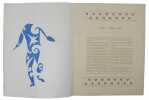

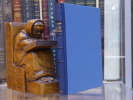
![Oeuvres.. Apollinaire (Guillaume) [ Picasso - Dufy - Folon -Glaser]](https://static.livre-rare-book.com/pictures/ATI/20823_1_thumb.jpg)
![Oeuvres.. Apollinaire (Guillaume) [ Picasso - Dufy - Folon -Glaser]](https://static.livre-rare-book.com/pictures/ATI/20823_2_thumb.jpg)
![Oeuvres.. Apollinaire (Guillaume) [ Picasso - Dufy - Folon -Glaser]](https://static.livre-rare-book.com/pictures/ATI/20823_3_thumb.jpg)



